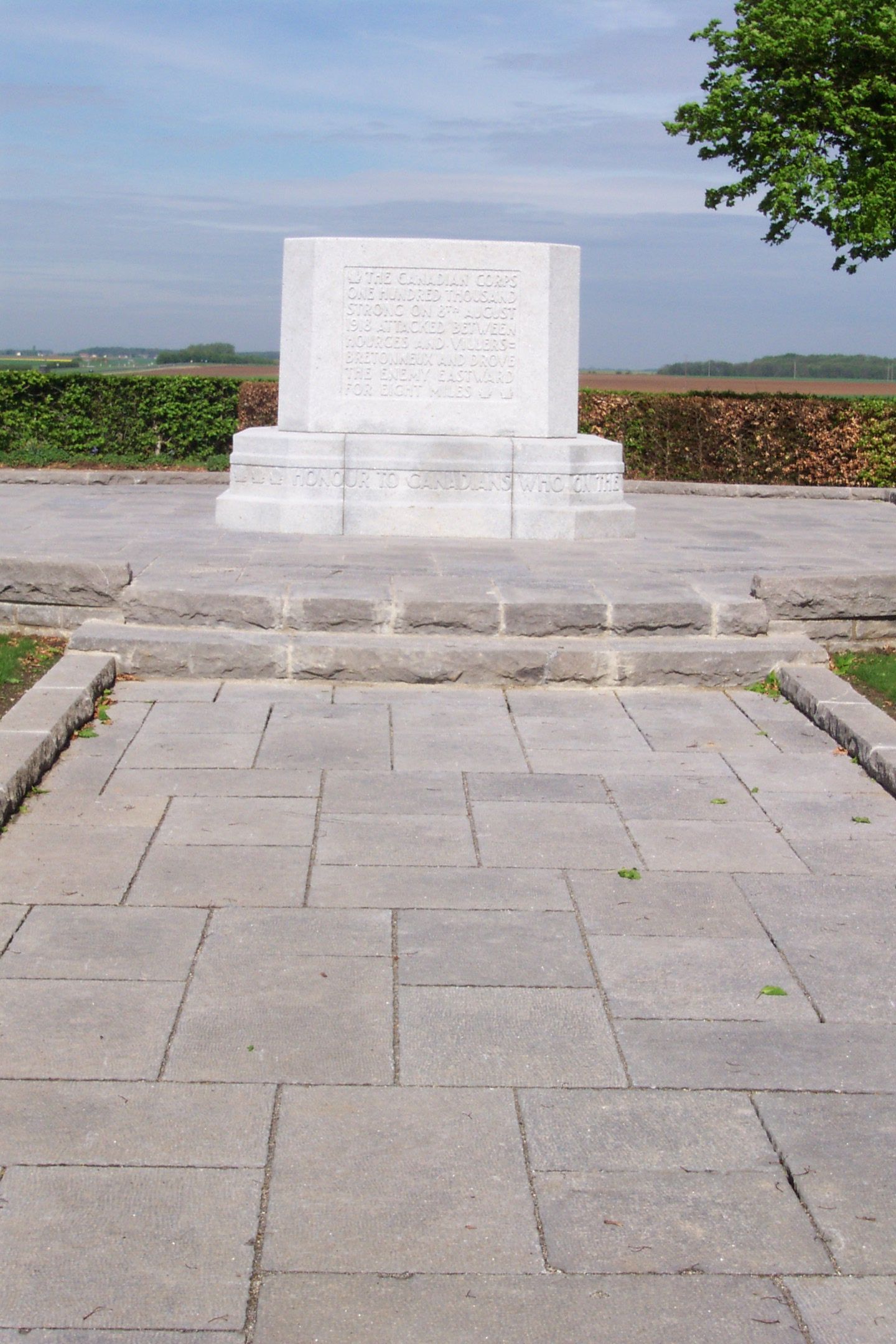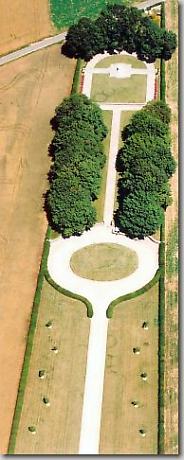Le Quesnel Canadian Memorial
At Le Quesnel, on the road from Amiens to Royce, the Le Quesnel Canadian Memorial, made of Quebec granite, pays tribute to the achievements of the Canadian Corps in the Battle of Amiens, 8-1 1 August, 1918. As with the others, its massive sides are inscribed in English and in French.
THE CANADIAN CORPS ONE HUNDRED THOUSAND STRONG ON 8TH AUGUST 1918 ATTACKED BETWEEN HOURGES AND VILLERS-BRETONNEUX AND DROVE THE ENEMY EASTWARD FOR EIGHT MILES
A maple-bordered avenue leads to this memorial, which is set in a bed of low growing conifers and is enclosed by a holly hedge. There are many variations of green provided by the fine specimens of shrubs and small trees that have been planted around the hedge. The effect is low-keyed, dignified and restrained.
The Battle of Amiens, 1918
On March 21, 1918, the Germans suddenly and unexpectedly struck at two British armies on the Western Front. That night they broke through the Fifth Army front. However, on April 5, they were held short of Amiens. The Canadian Cavalry Brigade, fighting both as cavalry and infantry (dismounted) helped bring this about.
Halted at Amiens, not having driven a wedge between the British and French, the Germans mounted offensives elsewhere on the Western Front. By now the Americans had arrived in force and the Allies had superior numbers. The time had come for a counter-blow.
The Canadian Corps, as such, had not taken part in these offensives. Haig had ordered the Canadians, piecemeal by divisions, to shore up the crumbling British front. By the time the German offensives had ended, the Canadians fielded a strong, fresh, well-trained and well-organized corps, ready to play an important part in the fighting that lay ahead.
For Amiens it was more important to conceal from the enemy the intentions of the Canadian Corps than any other formation. "Regarding them as storm troops," wrote Sir Basil Liddell Hart, an eminent British military historian, "the enemy tended to greet their appearance as an omen of a coming attack." A mock attack was therefore launched on the Arras front to delude the enemy and then, at the last possible moment before the real attack that was scheduled for August 8, the Corps was moved south to Amiens by night. The front of the attack extended 22.5 kilometres with the French in the southern half; the Fourth Army named two corps for the assault, the Canadians on the right and the Australians on the left, with the British 3rd Corps acting as flank-guard on the extreme left.
An hour before dawn on August 8, the attack began and surprise was total. More than 2,000 guns suddenly flashed out in barrage, while 420 tanks, closely followed by the infantry, surged forward over ground that was heavily shrouded in mist. German machine-gunners found few targets as the tanks, accompanied by determined men, crashed through their positions. The enemy artillery, which might have been counted on to break up the attack despite the fog, had been effectively neutralized by counter-battery fire; batteries were quickly overrun, many of them without having fired a shot. In what was then open warfare, massed cavalry and light "whippet" tanks swept ahead to exploit success. On that first victorious day, "The Black Day of the German Army", as the enemy termed it, the Canadians gained 13 kilometres, the Australians 11, the French eight and the British three. The Germans lost 27,000 men and 400 guns as well as hundreds of mortars and machine-guns. The Canadian Corps alone captured 5,033 prisoners and 161 guns. Against this, Fourth Army's casualties totalled 9,000 - about 4,000 for the Corps. The Battle of Amiens continued until August 11.
Directions
The Le Quesnel Canadian Memorial is about 20 kms southeast of Amiens, 75 kms south of Arras and 105 kms north of Paris. You can reach Amiens by train or by bus and from there take a taxi to the Memorial. The trip to the Memorial is approximately €65 return. You can also rent a bike at the train station, which costs approximately €5 per day, €11 per week and €17 per month.
Note: The cost of a taxi is based on return trips without a waiting period. If you want the taxi to wait for you while you visit the site you will be charged € 17.90 per hour. Bus connections are difficult and there are not many of them in the rural areas of the department of the Somme.
If you are travelling by car, please follow the directions below:
Note: Speed limits in France are 50 km/h in city limits and residential areas (generally unmarked), usually 90 km/h on secondary roads (but it may vary in areas) and 130 km/h on the motorway. Motorists should be aware of the priority from the right rule.
From Paris or Charles de Gaulle Airport take the A1 motorway, direction Lille. Continue on this road for approximately 90 kms. Take exit 12, direction Amiens, Roye , and continue on the D934 for about 15 kms. On the Amiens / Roye road you will pass the D41 intersection; the Memorial is about 1 km beyond that intersection on the north side of the road. It should take you approximately 1 to 1 ½ hours to reach the Memorial.
From Amiens take the D934. The Memorial is about 20 kms east of Amiens and 1.5 kms beyond the D28 intersection on the north side of the road. It should take you approximately 20 minutes to reach the Memorial. Be aware that to reach the Memorial it will be necessary to make a left turn on what is a very fast, two lane road.
From Arras take the A1 motorway, direction Paris. Continue on this road for approximately 60 kms. Take exit 12, direction Amiens, Roye, and continue on the D934 for about 15 kms. On the Amiens / Roye road you will pass the D41 intersection; the Memorial is about 1 km beyond that intersection on the north side of the road. It should take you approximately 1 to 1 ½ hours to reach the Memorial.
From Calais take the A26 and continue on this road for approximately 130 kms. Turn south on the A1 towards Paris and drive for about 60 kms. Take exit 12, direction Amiens, Roye, and continue on the D934 for about 15 kms. On the Amiens/Roye road you will pass the D41 intersection; the Memorial is about 1 km beyond that intersection on the north side of the road. It should take you approximately 2 to 2 ½ hours to reach the Memorial.
From Lille take the A1, direction Paris. Continue on this road for approximately 100 kms. Take exit 12, direction Amiens, Roye, and continue on the D934 for about 15 kms. On the Amiens / Roye road you will pass the D41 intersection; the Memorial is about 1 km beyond that intersection on the north side of the road. It should take you approximately 1 to 1 ½ hours to reach the Memorial.
- Date modified:

